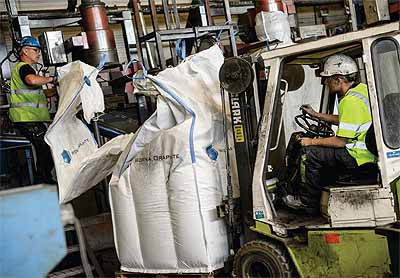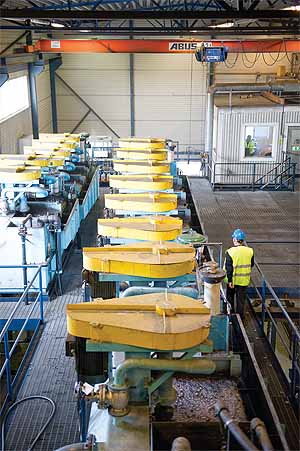Woxna Graphite
Energising change
As the world is on the cusp of a battery-powered revolution, Woxna Graphite is at the heart of ensuring the entire supply chain is ready to serve growing demand for high-purity graphite in a cost-effective and sustainable way
Speaking to Blair Way, CEO of TSX-listed Flinders Resources and Mikael Ranggard, responsible for sales and marketing at Woxna Graphite, there is a clear sense that the graphite industry  in Europe and North America is on the verge of revolutionary change. Based in Central Sweden at the Woxna graphite mines, Woxna’s processing facility ran operations from 1997 to 2002, primarily servicing the traditional graphite markets of refractory bricks, for steel production, and crucible applications. However, with the steel industry in Europe in decline, falling demand for graphite saw prices plummet, and despite the acquisition by Flinders in 2011, the subsequent refurbishment and 12 months of continued operation in July 2014, the facility now exists in a state of suspended operation.
in Europe and North America is on the verge of revolutionary change. Based in Central Sweden at the Woxna graphite mines, Woxna’s processing facility ran operations from 1997 to 2002, primarily servicing the traditional graphite markets of refractory bricks, for steel production, and crucible applications. However, with the steel industry in Europe in decline, falling demand for graphite saw prices plummet, and despite the acquisition by Flinders in 2011, the subsequent refurbishment and 12 months of continued operation in July 2014, the facility now exists in a state of suspended operation.
“The traditional market in Europe saw demand somewhere in the region of between 60,000 and 85,000 tonnes a year but with the steel industry’s downturn we estimate that demand dropped by at least 30 per cent,” Blair explains. “Therefore the decision was taken to put the Woxna facility into a production ready state during the summer 2015 annual maintenance shutdown. When the market conditions alter to make start up viable again it can be doen so very efficiently.”
When this will be is uncertain, but for Blair and Mikael the future of Woxna exists outside producing graphite commodities for these traditional markets and in the next stage of battery development. Possessing heat-resistant, electrical and thermal conductive, chemical-passive and lightweight properties, graphite is a vital component in Li-ion batteries, which appear in everything from smart phones and laptops to the emerging boom of electric vehicles and static energy storage solutions. Crucially, as demand for the technology rises, as too does the need for more efficient, lightweight, higher capacity and more reliable solutions, and of course graphite availability. There is also the future application of graphene, which could revolutionise the performance of electronics in years to come.
“Because of its range of high performance properties, there are a myriad of opportunities for graphite in a number of applications,” Blair continues. “However, these applications rely on value added graphite such as high purity spherical graphite, and will involve an upgrade at the existing facility to produce a wider range of products. Whilst this is relatively inexpensive and not overly complicated there is no point in entering production just yet as there are no customers in Europe producing battery cells to sell to. All battery cell manufacturers are currently based in Asia where there is already a strong presence of battery grade graphite suppliers, and whilst this is a market we would look to serve in the future we believe it is Europe and the US where the emerging market present the best opportunities.”
Elaborating on the competition in Asia, Mikael talks about the growing need for a European supplier and the challenges posed by the market’s present situation. “It is a fact that more or less 100 per cent of the world’s battery-quality graphite is produced in Asia and this is where the skills for doing so are,” he says. “However, you only have to look at the automotive industries in the US and Europe, with Tesla’s new Li-ion battery gigafactory as an example, as well as other applications like stationary energy storage, to see that demand is going to increase a lot over the coming years and it doesn’t make sense that all this high purity graphite comes only from China.
“For now the freight rate from Asia is exceptionally low, and unfortunately people are only looking at price and quality when it comes to their supply. However, the cells are heavy, dangerous and they’re still expensive to transport from Asia, when we could have a facility set up in Europe to serve the new demands in the US and Europe. As we move forward, I hope people start to consider the environmental impact of buying from Asia as well as just price and quality.”
Giving Woxna Graphite a key advantage in the race for battery-grade graphite supply in Europe and the US are a number of factors. Firstly, the amount of graphite producers with the permits and facilities in place to create high-purity graphite is incredibly low, in fact Woxna is one of only two on the continent. Secondly, are the critical relationships it has already established with Asian experts in converting its existing facilities into one capable of producing the new type of graphite. “Other companies that are looking at this opportunity are working with European or US engineering companies that have no experience with this type of facility or process, so having this from our Chinese partners is a big plus,” Blair explains. “Combined with the infrastructure and capacity we already have in place we’re potentially two years ahead of any competitors already.”
The opportunity for Woxna Graphite then is vast. Mikael notes a variety of ongoing discussions that will help solidify the case for a high-purity graphite facility in Europe to serve new and emerging customers and industries. Blair also points out that the opportunities created by this growing need for environmentally friendly energy storage solutions do not stop at graphite production. “We have identified from speaking with many of the end users that it is not just graphite that they’re looking for, but other value added resources such as lithium,” he notes. “By Autumn 2016 we will have completed a merger with a company called Tasman Metals – another TSX listed company – to bring together two very strong assets at the same time as pursing other commodities that will serve the green energy storage market. Ultimately, it’s about becoming more than just a mining company, but one that can supply specialised, individually specified and value-added quality products to the entire supply chain, right down to the end user.”
As Mikael points out, it is an incredibly exciting time for the industry: “Something big is happening and everybody will start seeing big changes in the products they are using over the coming years. It’s extremely interesting and has the potential to impact on the world in a really positive way. It is vital then that we are able to set up a strong position in Europe to serve this trend.”
Woxna Graphite
Services: Own and operate one of Europe’s only graphite production facilities
